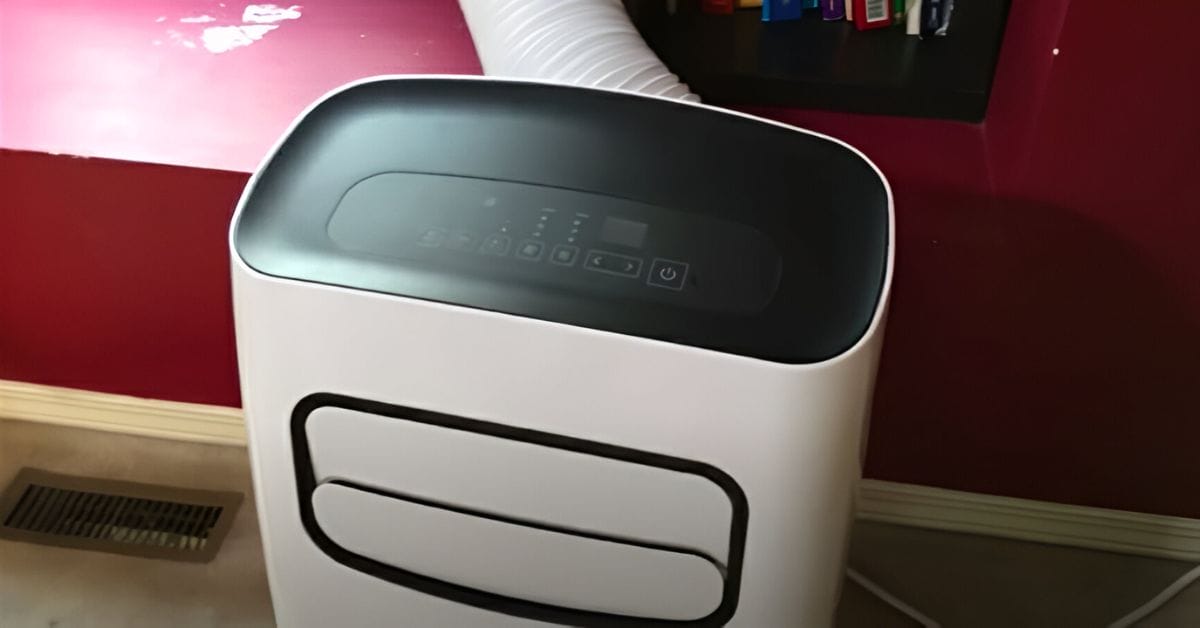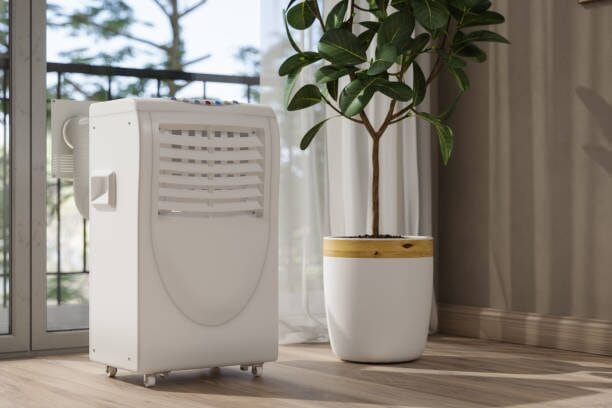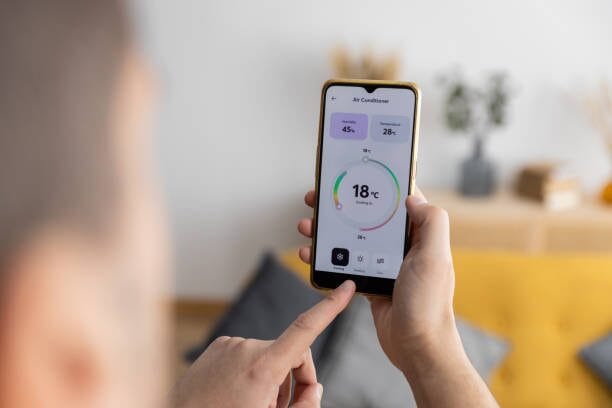How Much Electric Wattage Does a Portable Air Conditioner Use?

Hey everyone, let’s dive into the world of portable air conditioners and their power needs. It’s fascinating how much the electricity usage can vary based on the model and size of these units.
From my experience, you’ve got to know that the average portable air conditioner will use around 1,176 watts every hour. But here’s the thing: that number can change greatly depending on your model.
This article will delve deeper into portable air conditioners, moving beyond average wattage. Stay tuned for a deep dive into maximizing efficiency and managing costs with your portable air conditioner.
Understanding the Wattage of Your Portable Air Conditioner

Let’s talk about what’s going on with the wattage of portable air conditioners. It’s like the heartbeat of these units – the key to understanding their power needs.
So, here’s the lowdown: the wattage, which is the power rating, tells you the maximum watts your portable air conditioner will use. Think of it as the peak of what it needs to keep you cool.
Manufacturers put these numbers out but remember; they don’t always include the extra bits like standby power or those bursts of energy at startup.
Let’s put some numbers to this. On average, portable air conditioners use about 1,176 watts every hour. That’s 1.176 kWh for those who love their kilowatt-hours. But it’s not a one-size-fits-all situation. Different sizes mean different power usage:
- Compact units? They’ll use between 500 and 900 watts each hour.
- Mid-range units step it up to around 2,900 watts per hour.
- And the big guys? They can go up to 4,100 watts per hour.
Most portable air conditioners are smaller, averaging between 940 and 1,650 watts per hour.
Here’s a sneaky part: even when they’re off, they still use power if plugged in. With its little LED lights and timers, this standby mode can use about 1 to 6 watts per hour.
And let’s not forget about startup power. When you turn these units on, they might surge up, using more power than usual, but it’s just for a short burst. The good news? They tend to be more power-efficient when they’re running for longer periods.
The best way to know what you’re dealing with is to check the manufacturer’s manual of your model. It’s all about understanding your unit to use it efficiently and smartly. Stay cool!
Cost Analysis of Running a Portable Air Conditioner
Let’s break down the costs of running a portable air conditioner. It’s important to know what you’re getting into financially when you’re keeping cool. So, I’ve put together a straightforward table to help you understand the cost implications.
| Air Conditioner Size | Average Power Usage (Watts per Hour) | Cost for 1 Hour | Cost for 8 Hours (Overnight) | Cost for 30 Days (8 Hours Daily) |
|---|---|---|---|---|
| Compact (500-900 W) | 700 | $0.091 | $0.728 | $21.84 |
| Mid-Range (940-1650 W) | 1300 | $0.169 | $1.352 | $40.56 |
| Large (2900-4100 W) | 3500 | $0.455 | $3.64 | $109.20 |
Remember, the actual cost will depend on your local electricity rates, but I’m using a standard rate of 13 cents per kilowatt-hour (kWh) for this example.
These calculations are based on a few assumptions:
- The AC unit is running continuously during its operation period.
- Standby power consumption is minimal and not factored into this calculation.
- The electricity rate is constant. Remember, rates can vary based on location and time of day.
Understanding these costs is crucial, especially if you plan to use your portable air conditioner regularly. It helps you budget better and make informed decisions about how often and long to run your unit. Keep cool and budget smart!
Key Factors Impacting Your Portable AC’s Efficiency
Let’s dive into what affects your portable air conditioners’ energy efficiency and electricity consumption. Knowing these factors can help you get the most out of your unit without hiking up your energy bills.

Temperature Settings
- First up, temperature settings. It’s a bit like setting the pace for a marathon – find a good, steady pace and stick with it. The trick with portable ACs is to keep the temperature setting consistent.
- Cranking it down to cooler settings means your unit has to work harder, which, in turn, spikes up the electricity usage. So, constant fiddling with the temperature can lead to more power consumption. Find your comfort zone and stay there.
Regular Maintenance
- You are getting your portable air conditioner serviced by a pro at least twice a year. But there’s plenty you can do yourself, too. Simple things like cleaning or replacing the air filters can make a difference. A clean filter means better airflow and more efficient cooling.
- And watch for any signs of trouble, like water leaks or unusual noises. Spotting these early and getting them fixed by a specialist can save you a lot of headaches and keep your unit running efficiently.
Room Insulation
- The insulation of your room plays a huge role. If you’ve poor insulation, your AC will work overtime to cool the space. It’s like trying to fill a bathtub with the drain open.
- So, check for drafts around windows and doors. Proper insulation can keep the cool air in and reduce the workload on your AC.
AC Placement
- Where you place your portable AC matters, too; avoid putting it near heat sources like direct sunlight or appliances that give off heat. Also, ensure it has good air circulation around it.
- Don’t trap it in a corner or behind furniture. Good placement means more efficient cooling.
Humidity Levels
- High humidity can make your AC work harder. It’s not just about cooling the air; it’s about removing moisture too. Consider using a dehumidifier alongside your AC if your area is particularly humid. This can help make the environment more comfortable and ease the load on your AC.
Upkeep of External Components
- Don’t forget the external parts like the exhaust hose. Ensure it’s not kinked or blocked. A well-maintained exhaust system helps your AC function efficiently.
Considering all these factors, you’re helping your portable air conditioner work better and optimizing energy use. It’s all about smart use and good care to keep your space cool without sending your energy bills through the roof. Stay cool and efficient, and remember, every little bit helps!
DIY Maintenance Tips for Your Portable Air Conditioner
Let’s talk about keeping your portable air conditioner in top shape. Trust me, a little TLC goes a long way in maintaining efficiency and longevity. I’ve had my fair share of maintenance adventures, and I’m here to share some handy DIY tips.
Regular Filter Cleaning
- First things first, the filter. This is something I check often. A clogged filter can hamper the efficiency of your AC.
- It’s simple: slide the filter out, rinse it under warm water, and let it air dry. I make it a point to do this every few weeks during heavy use.
Coil Cleaning
- Now, onto the coils. Dirty coils are no joke—they can significantly reduce cooling efficiency. Mix a mild detergent solution and water, then gently brush the coils.
- Be careful not to bend them. I do this at the start and end of the cooling season.
Checking for Refrigerant Leaks
- Refrigerant leaks can be trickier, but they’re important to address. If your unit isn’t cooling as well as it used to, it might be a sign.
- I usually check the connections and the hose for any signs of leakage. Calling in a pro is often best if you suspect a leak.
Unclogging the Drain Line
- The drain line can get clogged over time. I learned this the hard way when my unit started leaking water inside. A simple way to keep it clean is to flush it with vinegar and water solution every few months. It keeps things running smoothly.
Ensuring Proper Ventilation
- Proper ventilation is key. I always make sure the exhaust hose isn’t kinked or blocked. It should be as straight as possible to vent hot air efficiently. This is a quick check I do now and then.
General Unit Cleaning
- Don’t forget the exterior. Dust and dirt on your unit can get inside and affect performance. A soft, damp cloth usually does the trick for me. It’s a quick wipe-down, nothing too time-consuming.
Following these simple maintenance tips saves you on potential repair costs and ensures your portable air conditioner runs efficiently. Trust me, a little effort can go a long way. Stay cool and enjoy the comfort of a well-maintained AC!
Frequently Asked Question
- Is It More Efficient To Keep The AC Running Or Turn It On And Off?
- It’s generally more efficient to keep the temperature setting constant. Frequently turning it on and off can cause power surges, leading to higher electricity usage.
- Does Room Size Affect The AC’s Efficiency?
- Yes, it does. Matching your AC’s capacity to the size of the room is key. An undersized AC in a large room will have to work harder, using more energy.
- Are Portable Air Conditioners More Efficient Than Window Units?
- It depends on the specific models you’re comparing. Portable air conditioners offer flexibility and can be energy efficient, but some window units are designed for higher efficiency.
- Does The Length Of The Exhaust Hose Affect Efficiency?
- Yes, it can. A longer exhaust hose can reduce efficiency, making the unit work harder to expel hot air. Keeping the hose as short and straight as possible is best.
References
Organizations:
- U.S. Department of Energy (DOE). https://www.energy.gov/
- Energy Star Program. https://www.energystar.gov/
- American Council for an Energy-Efficient Economy (ACEEE). https://www.aceee.org/
Books:
- “Consumer Guide to Home Savings” by Jennifer Thorne Amann, Alex Wilson, and Katie Ackerly. https://www.barnesandnoble.com/w/consumer-guide-to-home-energy-savings-10th-edition-jennifer-amann/1131331902
Website Resources:
- Environmental Protection Agency (EPA). https://www.epa.gov/home
